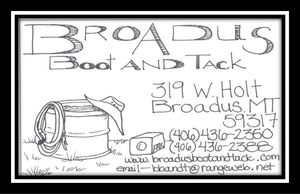Rattlesnake bite sends teacher to hospital
August 9, 2018
While we all receive bites from various critters during the warm summer months, most of the bites, such as those from mosquitoes and horse flies, are relatively innocuous, and not life threatening. On Friday, Biddle School Teacher Sherrie Bassett received a bite that did not fit this description.
While walking amongst the tall grasses, Russian olives, and various shrubs lining the Powder River, Sherrie felt a sharp pain on the back of her calf. The bite came from a rattlesnake.
“I knew right away I had been bit,” she said.
The snake, which Sherrie did not see or hear rattle, had bitten through Sherrie’s leggings, and injected its venom into her system. Sherrie said that her leg went instantly numb, severely limiting her ability to walk back to her vehicle, and she did not have a cell phone to call 911.
Fortunately help was not far away – Sherrie’s fiancé, Eric Fredrickson, heard Sherrie’s screams and came running. Eric was able to carry Sherrie back to a vehicle, and head towards a higher level of care. Dillon Isaak and Colby Trumps, who had been setting out antelope blinds in the area, came across Sherrie and Eric and then called for help.
Powder River First Responders Shane and Kesa Copps then headed out to meet Sherrie, and were able to transfer her into the ambulance partway between Fredrickson’s place and town; the ambulance was able to get spooled up and going within a few minutes.
In speaking to Shane Copps on Tuesday, when the call came in for a snake bite victim, Copps made phone calls to area hospitals to see who had anti-venom readily available. Anti-venom has a short shelf life, Copps said, and only a limited number of doses are kept on hand – and if another snake bite had been treated recently, a hospital may not have any.
The hospital in Spearfish had anti-venom on hand, but a storm between Broadus and Spearfish meant that life-flight was not available at the time of the call.
A decision was made to transport Sherrie to Miles City, and the ambulance raced for Custer County. During the trip, Copps was able to calm down Sherrie’s heart rate, which had been racing, pumping the venom throughout her system.
Upon reaching Miles, anti-venom was quickly administered, but due to the severity of Sherrie’s bite, she needed more anti-venom than Miles City had available. This is not uncommon, in researching anti-venom, double digit numbers of anti-venom may be administered, with costs up to $14,000 per vial.
Sherrie was life-flighted to Billings, where more anti-venom was available. Bassett was eventually released over the weekend.
Bassett is currently at home recovering, and expects to make a full recovery and be back to work teaching at Biddle in a few weeks.
Sherrie wanted to thank Shane and Kesa Copps for their quick work, as well as Dillon and Colby, and most importantly her fiancé Eric for saving her.
Sherrie’s experience is one that could easily happen to any of us who traipse through the countryside. The prairie rattlesnake, which is Montana’s only naturally occurring poisonous snake, is able to inject 20-50% of its venom in a single bite. Though fatalities from the prairie rattler are quite rare, a golfer near Spearfish died earlier this year after being struck by a rattler while searching for his ball in the rough.
Many of the “treatments” for snake bites, such as sucking the venom out, or cutting open the skin for the venom to seep out are either useless, create more problems, or are just dangerous, according to experts.
“The best thing you can do if bit by a snake is to call 911, and remain calm,” Shane Copps said. The ambulance has nitrous-oxide on hand to keep the patient’s heart rate down, which helps to keep the venom from doing more damage. Also, the ambulance crew will be able to locate anti-venom and either have it on the way from a hospital, or get the patient to a hospital quickly. Copps concluded: “The important thing, not just with a snake bite but with any major injury, is to get the person to a higher level of care. We have a number of medications and tools on board the ambulance to help a person out immediately, so please call 911.”
The best treatment for a snake bite is, of course, to not get bitten in the first place. That’s easier said than done, as the Rocky Mountain Poison and Drug Center in Denver says that around 5 or 6 people are bitten by rattlesnakes every year in Montana.









Reader Comments(0)